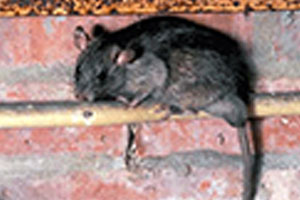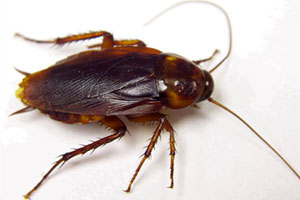Roof Rat
 Roof Rats are probably the most common rat species found. They were unknown in Arizona until 2002, when they started to show up in the eastern part of Phoenix, probably unintentionally imported from another state. By 2004, they were well-established throughout neighboring towns and cities. They are also known as Alexandrian rats, Black rats, Fruit rats and Ship rats. They will explore their usual territory daily, covering about 100 to 300 feet. Rats will frequent the same areas and travel the same runways daily. Because they are nocturnal by habit, most of their activity is at night. The body is slender, from 6 1/2 to 8 inches long. They have an average weight of 6 to 12 ounces. Their color varies from black to brownish-gray, with the underside being gray to white. The tail is hairless and longer than the head and body, from 7 1/2 to 10 inches long. Roof rats will not only nest in trees (especially palms), ivy, and ground cover, but also in upper portions of buildings. They are omnivores–their food source consists of snails, fruits, grains, vegetables, nuts and seeds, pet food and items from unsealed garbage containers, and just about anything leftover from humans. Rat’s visit fewer food sites than mice, but will eat more at each site. They usually consume 1/2 to 1 ounce of food daily, and drink up to 1 ounce of water daily. A water source is also essential.
Roof Rats are probably the most common rat species found. They were unknown in Arizona until 2002, when they started to show up in the eastern part of Phoenix, probably unintentionally imported from another state. By 2004, they were well-established throughout neighboring towns and cities. They are also known as Alexandrian rats, Black rats, Fruit rats and Ship rats. They will explore their usual territory daily, covering about 100 to 300 feet. Rats will frequent the same areas and travel the same runways daily. Because they are nocturnal by habit, most of their activity is at night. The body is slender, from 6 1/2 to 8 inches long. They have an average weight of 6 to 12 ounces. Their color varies from black to brownish-gray, with the underside being gray to white. The tail is hairless and longer than the head and body, from 7 1/2 to 10 inches long. Roof rats will not only nest in trees (especially palms), ivy, and ground cover, but also in upper portions of buildings. They are omnivores–their food source consists of snails, fruits, grains, vegetables, nuts and seeds, pet food and items from unsealed garbage containers, and just about anything leftover from humans. Rat’s visit fewer food sites than mice, but will eat more at each site. They usually consume 1/2 to 1 ounce of food daily, and drink up to 1 ounce of water daily. A water source is also essential.
 The Roof rat is distinguished by its larger ears, pointed nose, a tail that is longer than the body, and an average body weight of 6-12 ounces. Roof rats also have an acute sense of smell. Best suited for tropical and semitropical zones, Roof rats are found along the Pacific Coast, in Hawaii, along the lower half of the East Coast, throughout the Gulf States and major river systems (i.e., Mississippi River). Rats spread disease, damage structures, and contaminate food, animal feed, and the environment around them. Because a single pair of rats shed more than one million body hairs each year, and a single rat will produce 25,000 droppings per year, contamination is a serious problem. Additionally, the physical damage to structures which can include electrical, plumbing, and woodwork problems can be extensive and costly.
The Roof rat is distinguished by its larger ears, pointed nose, a tail that is longer than the body, and an average body weight of 6-12 ounces. Roof rats also have an acute sense of smell. Best suited for tropical and semitropical zones, Roof rats are found along the Pacific Coast, in Hawaii, along the lower half of the East Coast, throughout the Gulf States and major river systems (i.e., Mississippi River). Rats spread disease, damage structures, and contaminate food, animal feed, and the environment around them. Because a single pair of rats shed more than one million body hairs each year, and a single rat will produce 25,000 droppings per year, contamination is a serious problem. Additionally, the physical damage to structures which can include electrical, plumbing, and woodwork problems can be extensive and costly.
Life cycle of the Roof Rat
The female Roof rat reaches sexual maturity at 3 months of age. They are in heat approximately every 4-5 days. The gestation period is 21 to 23 days, with each litter being 5-8 pups. After giving birth the female is capable of being in heat again in 24 to 48 hours, so many generations can be produced each year.








